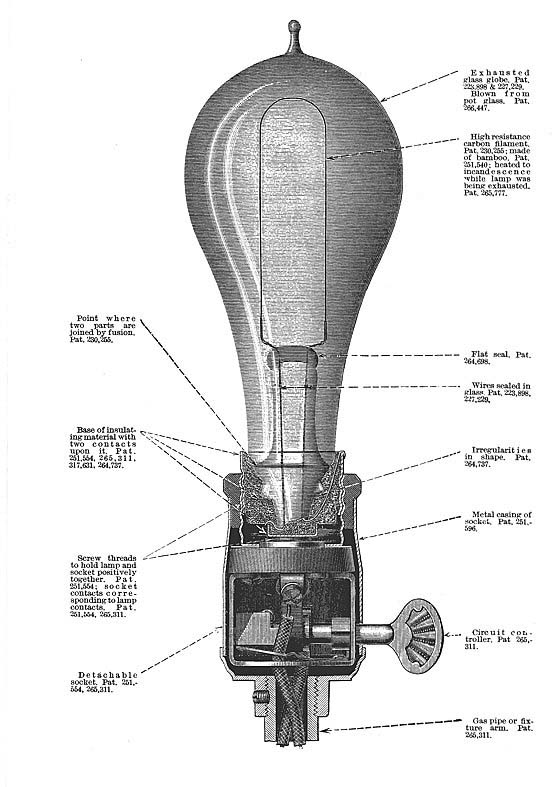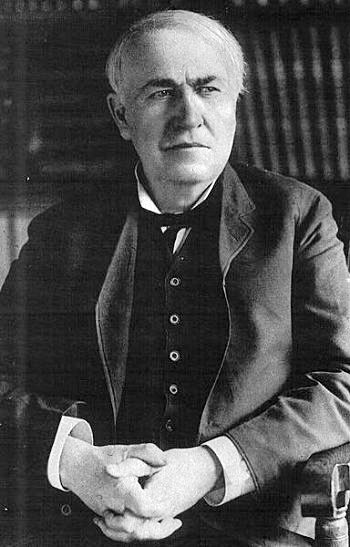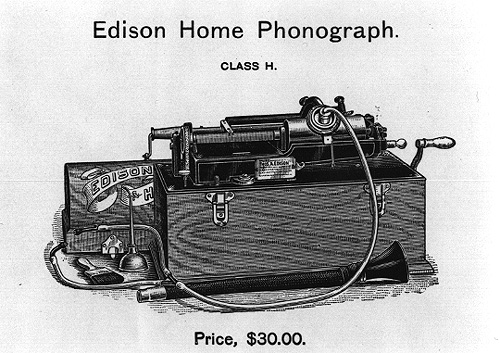1875, Edison
discovered a new phenomenon. This was a spark which jumped from a
magnet. Edison called the discovery "etheric
force." Although
he did not know it at the time, it was this new discovery which would
lead to wireless communication. However, Edison passed up further
research on the subject in order to work on experiments for the
telephone. Edison was able to patent a telephone which more useful
than Bell's. Bell was Edison's main competition for work on the
telephone at the time. He received the patent in 1876. Edison spent
much of 1877 searching for a better transmitter for the telephone. 1878
Edison patented a new telephone transmitter. This would lead to the
first microphone.
During a vacation during August of 1878 Edison went fishing. While at Battle Lake the fiber of his bamboo fishing pole caught his interest. Later he would use the fiber for the filament of his incandescent lamp. In 1877 Edison had worked with carbon with efforts to create practical lighting. However, the use of gas illumination was what took Edison's mind. The Edison Electric Company was formed October of 1878 in order for Edison to work on the creation of light.

 Edison wished to
subdivide electricity, previously undone, in order to control
individual lights using less electricity. This desire lead to the
incandescent lamp. The main problem which pursued Edison was that
oxygen would burn up the filament far too fast. The new Sprengel pump
would be used to pump air out of a glass bulb where a platinum filament
wire would be used. This light bulb was capable of creating the bright
25 candlepower. However, pressing matters forced Edison to return to
telephones for a while.
Edison wished to
subdivide electricity, previously undone, in order to control
individual lights using less electricity. This desire lead to the
incandescent lamp. The main problem which pursued Edison was that
oxygen would burn up the filament far too fast. The new Sprengel pump
would be used to pump air out of a glass bulb where a platinum filament
wire would be used. This light bulb was capable of creating the bright
25 candlepower. However, pressing matters forced Edison to return to
telephones for a while.
Then by accident Edison came
up with the phonograph, or as one
newspaper referred to it a "talking machine." In order to protect this
new invention, Edison wanted to patent up to twelve versions of the
phonograph of which he could think of. He was granted a patent 1878.
The phonograph would revolutionize the world of sound. An instrument
which could record and replay sound.
During a vacation during August of 1878 Edison went fishing. While at Battle Lake the fiber of his bamboo fishing pole caught his interest. Later he would use the fiber for the filament of his incandescent lamp. In 1877 Edison had worked with carbon with efforts to create practical lighting. However, the use of gas illumination was what took Edison's mind. The Edison Electric Company was formed October of 1878 in order for Edison to work on the creation of light.

 Edison wished to
subdivide electricity, previously undone, in order to control
individual lights using less electricity. This desire lead to the
incandescent lamp. The main problem which pursued Edison was that
oxygen would burn up the filament far too fast. The new Sprengel pump
would be used to pump air out of a glass bulb where a platinum filament
wire would be used. This light bulb was capable of creating the bright
25 candlepower. However, pressing matters forced Edison to return to
telephones for a while.
Edison wished to
subdivide electricity, previously undone, in order to control
individual lights using less electricity. This desire lead to the
incandescent lamp. The main problem which pursued Edison was that
oxygen would burn up the filament far too fast. The new Sprengel pump
would be used to pump air out of a glass bulb where a platinum filament
wire would be used. This light bulb was capable of creating the bright
25 candlepower. However, pressing matters forced Edison to return to
telephones for a while.Edison returned to his
research on light April 1879. It was October of that year which he
created the incandescent lamp which was practical. It would last for 45
hours. This was achieved using a vacuumed bulb with platinum wires
connected with a special filament made from cotton thread, lamp black,
and tar. Edison applied for a patent on the new lamp November 1879
after the news of the invention
been leaked. Stock for
Edison Electric rose to an astounding high after a front-page story of
his creation had hit the papers.
 Thomas Alva Edison moved on to work on many projects with
electricity, motors, and communication. The improvements he would make
on his past inventions would lead to bigger and better ones. Such as
the patent Edison would have for wireless telegraphy, 1885.
Thomas Alva Edison moved on to work on many projects with
electricity, motors, and communication. The improvements he would make
on his past inventions would lead to bigger and better ones. Such as
the patent Edison would have for wireless telegraphy, 1885.
No doubt Edison has had a great impact on the whole world. His inventions would forever change science and everyday life. He received many awards and titles up until his death October, 18 1931. Edison accumulated over 65 medals, and has many monuments to his success. Including the Edison Museum in Texas. He had obtained over 1090 patents by the age of 83. His last patent was the year before his death.
 Thomas Alva Edison moved on to work on many projects with
electricity, motors, and communication. The improvements he would make
on his past inventions would lead to bigger and better ones. Such as
the patent Edison would have for wireless telegraphy, 1885.
Thomas Alva Edison moved on to work on many projects with
electricity, motors, and communication. The improvements he would make
on his past inventions would lead to bigger and better ones. Such as
the patent Edison would have for wireless telegraphy, 1885. No doubt Edison has had a great impact on the whole world. His inventions would forever change science and everyday life. He received many awards and titles up until his death October, 18 1931. Edison accumulated over 65 medals, and has many monuments to his success. Including the Edison Museum in Texas. He had obtained over 1090 patents by the age of 83. His last patent was the year before his death.
"In Thomas Alva Edison we
have a rough-hewn, old fashioned American
individualist who has been generally recognized as one of the most prolific
inventors known to history."
individualist who has been generally recognized as one of the most prolific
inventors known to history."
Matthew Johnson



